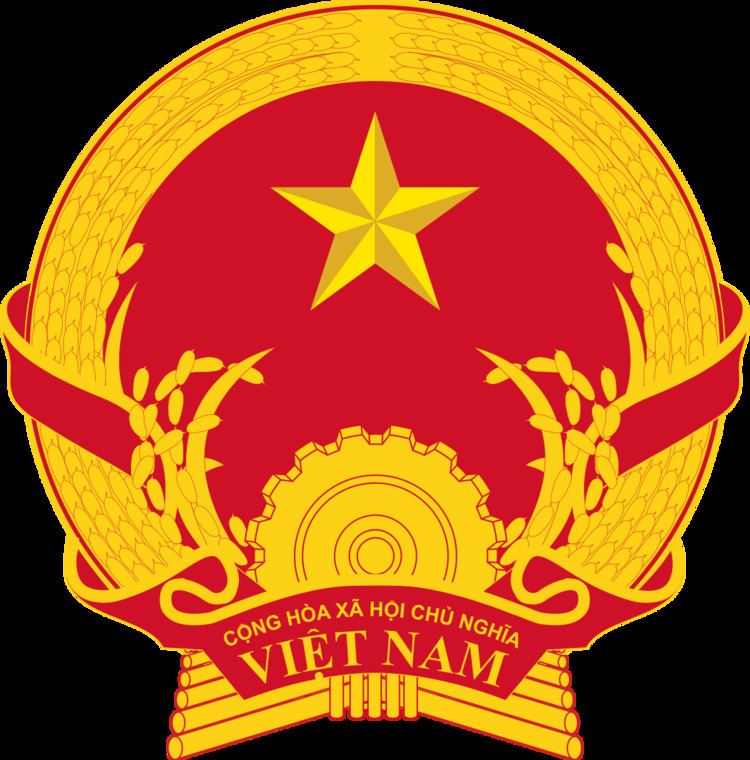Lyrics Văn Cao, 1944 Relinquished 1976 (North Vietnam) | Music Văn Cao, 1944 | |
 | ||
Adopted 1945 (North Vietnam)
1976 (Vietnam) | ||
The "Marching Song" (Vietnamese: Tiến Quân Ca, [tjə̌n kwən kaː]), also known as the "Army March" and the "Song of Advancing Soldiers", is the national anthem of Vietnam, both written and composed by Văn Cao in 1944. The "Marching Song" was adopted as the national anthem of North Vietnam in 1945, and was adopted as the national anthem of the new Socialist Republic of Vietnam in 1976, following the reunification of both North Vietnam and South Vietnam at the end of the Vietnam War.
Contents
Early History
About the track, Van Cao says, song title and its lyrics are a continuation from previous marches song "Thang Long" lyrics : "Along the way forward into the high standing of Thang Long" and from "Dong Da": "Tien quan ca march, scream rang remote jungle" ... And he has backed off in the song lyrics of "Tiến Quân Ca". Part of the lyrics of the song at the time of new birth is quite different compared to the latter, as the first sentence Đoàn quân Việt Nam đi, is originally Đoàn quân Việt Minh đi, the sixth sentence of the original version as Thề phanh thây uống máu quân thù expressed indignation, pain of Van Cao before the brutality of French colonial and pre famine was happening. Then, as following many suggestions, the author has changed to Đường vinh quang xây xác quân thù. The last sentence Tiến lên! Cùng thét lên! Chí trai là nơi đây ước nguyền! has been changed to (...)Núi sông Việt Nam ta vững bền, but when publishing, someone changed it to (...)Nước non Việt Nam ta vững bền, which, according to Van Cao, "With a song requires solemn, the nước non seemed to be so weak when being sung while the núi sông could be more reasonable to replaces".
After completion of work, Van Cao met and let Vu Quy try the song. Vu Quy was very happy, he let Van Cao wrote the lyrics himshelf into printing machine. And it was the first time Tiến quân ca printed on Arts of The Independence in November 1944 by lithographs by Van Cao.
August 17, 1945, the song was sung for the first time before the public at a rally of civil servants Hanoi by Ph. D., who was let go this is a red flag with yellow star on behalf of the flag of Vietnam Ming Tran Trong Kim government and robbed loudspeakers Marching and sung the song, which, according to Van Cao: "That Quiet Man's had attraction to thousands people appealing that day".
About the poet, musician Nguyen Dinh Thi, after hearing Van Cao sing this song, was really touched, and ask each person to write another song for The Viet Minh Frontline. Then Nguyen Dinh Thi post his own Diệt phát xít (Kills Fascists), Van Cao wrote Chiến sĩ Việt Nam (Vietnam Soldiers), both songs are widely popular to the public.
National Anthem
On August 13, 1945, President Ho Chi Minh approved Tiến Quân Ca to be officially recognized as the anthem of the Democratic Republic of Vietnam. On August 17, 1945, in a people's rally at Hanoi Opera House, the song was performed for the first time in front of the public. Also in the Square, on August 19, 1945, in a rally, choir of Young Pioneers Marching to greet the Red Flag With Yellow Stars.
On September 2, 1945, Marching officially performed in the day of the Declaration of Independence at Ba Dinh Square by band Liberation Army commanded by Dinh Ngoc Lien. Day before the performance, musicians Dinh Ngoc Lien, Nguyen Huu Hieu and musician Van Cao discussed for changing the two words in the Tien quan ca in order to shorten the song, or namely shortening the length of the first E pitches in the word "đoàn" and the F in the middle of the word "xác" to make the song more snappy.
In 1946, the 1st National Assembly officially recognized "Tiến Quân Ca" as the national anthem. In the first Constitution of the State of Vietnam, in Article 3: "National Anthem is the Tien Quan Ca". In 1955, the 5th session of the first National Assembly has decided to invite authors to participate to the editing of the song. Van Cao lately regret because a little of heroic spirit of the song have lost after edited.
After 1975, the government of South Vietnam fell, and on July 2, 1976, the two parties agreed to reunification (which lead to the establishment of the Socialist Republic of Vietnam) and chose the Tien Quan Ca as National Anthem. In 1981, Vietnam anthem organizational change. A contest is opened but after more a year, this contest has never been mentioned again and there is no official statement about the results. Marching song anthem Vietnam remains today.
On July 8, 2016, Painter Văn Thao, the eldest son of Van Cao confirmed that he and his family decided to donate the song to the State and the people as his father's last wish. A letter, signed by all the legal inheritors in the family, states clearly that the family is donating the song for free use by the State in any form, was sent lately.
On July 15, 2016, The National Assembly Office held a ceremony in Hanoi to receive the national anthem Tien Quan Ca (The Marching Song), donated by Van Cao's family members.
